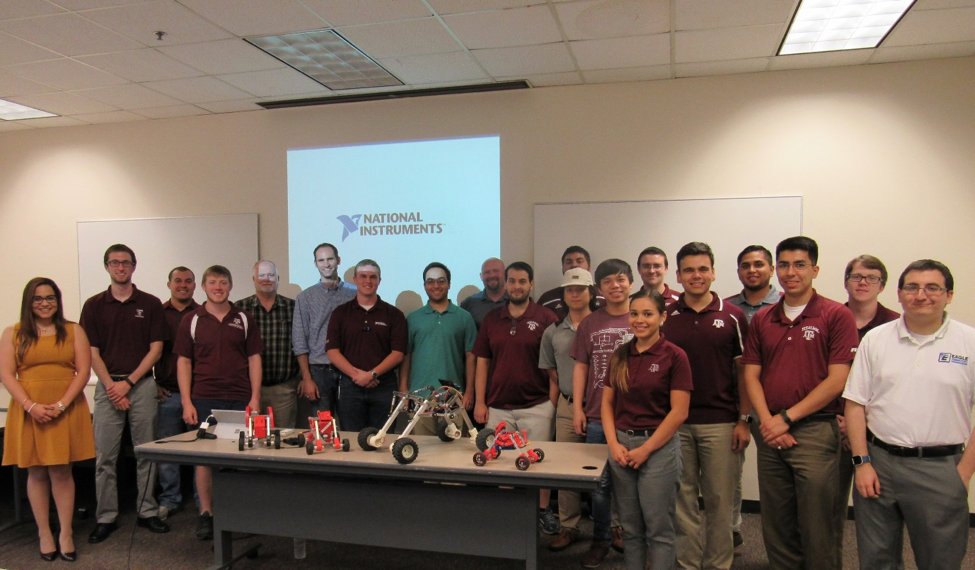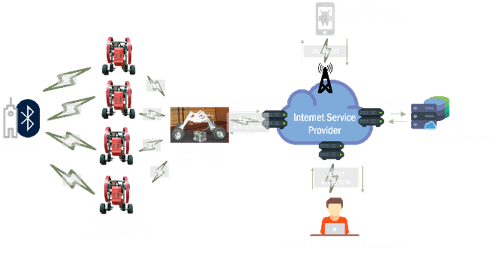
The Department of Engineering Technology and Industrial Distribution at Texas A&M University recently contacted Dr. John Hill, senior group manager for Cloud and Mobile Technologies within National Instruments Research and Development Group, about working with 14 students in the Electronic Systems Engineering Technology (ESET) Program on a new technical elective focusing on Internet of Things (IoT).

Hill had one condition — the project-based course had to include robotic systems. As a result, the ESET created the Robotic IoT Systems, or RIoTS, experiential learning opportunity during the first summer session.
The project, in part defined by the students, employed the ESET small form factor DSTR (pronounced Disaster) robot powered by the Texas Instrument SensorTag as the primary edge device. DSTR’s bigger brother, ASEP, powered by the National Instruments myRIO embedded controller, was used as a Gateway device for the IoT system. The project also incorporated PTC’s ThingWorx Cloud Development Environment and data analytics proposed by Sparkcognition.
National Instruments (NI) took on the industry leadership role and worked closely with the ESET faculty and students. Its contributions made the course an exciting and relevant learning experience for everyone. Hall was not only able to bring in a number of subject matter experts from NI, but was also able to identify and introduce the program to several other companies involved in the development of IoT technology and systems.
Included in this group were representatives from Cisco Systems, PTC and Sparkcognition. Leveraging other industry contacts, ESET was able to arrange for presentations by industry experts from Texas Instruments, DENSO and Schneider Electric. Although a small number of the guest lectures were made using video conferencing, many were made in person at Texas A&M. To kick off the course, NI invited the entire class to spend the day interacting with its IoT experts and touring the labs where IoT development is in progress.
“Learning from a textbook just doesn’t compare to interacting with practicing engineers who are developing the technology now,” said one of the ESET students.
To give the course focus, a mission statement was created as part of the day-long visit to NI. The NI engineers and students decided the goals of the course would be:
- The DSTR Robots controlled by TI SensorTags as edge devices would sweep a minefield to detect mines.
- The DSTR Robots would then determine their position and report the location of the mine to an ASEP Robot controlled by an NI myRIO over Bluetooth low energy wireless communications.
- The ASEP Robot would receive information from the swarm of DSTR Robots and move this information to the cloud over 802.11 wireless communications.
- Using both a MySQL database developed by the students and a MashUp created using PTC ThingWorx, the information was received, stored and analyzed to determine the safest path for the ASEP Robot to negotiate the mine field.
- An Android cell phone app was also developed that allowed for the real-time display of DSTR Robots and the mines they had detected. The app allowed the user to start, pause, and stop the operation of the robots over the 4G cellular network via the cloud service.
- Document the work done by the student group in a final report.
Because of time and budget constraints, the students were not able to complete the entire mission, but each team was able to contribute value to the overall defined mission. In addition to the technical work, the students prepared and delivered two design reviews to the NI subject matter experts. Several students are continuing to work on the project over the remainder of the summer to fully develop a demonstrable Robotic IoT System.